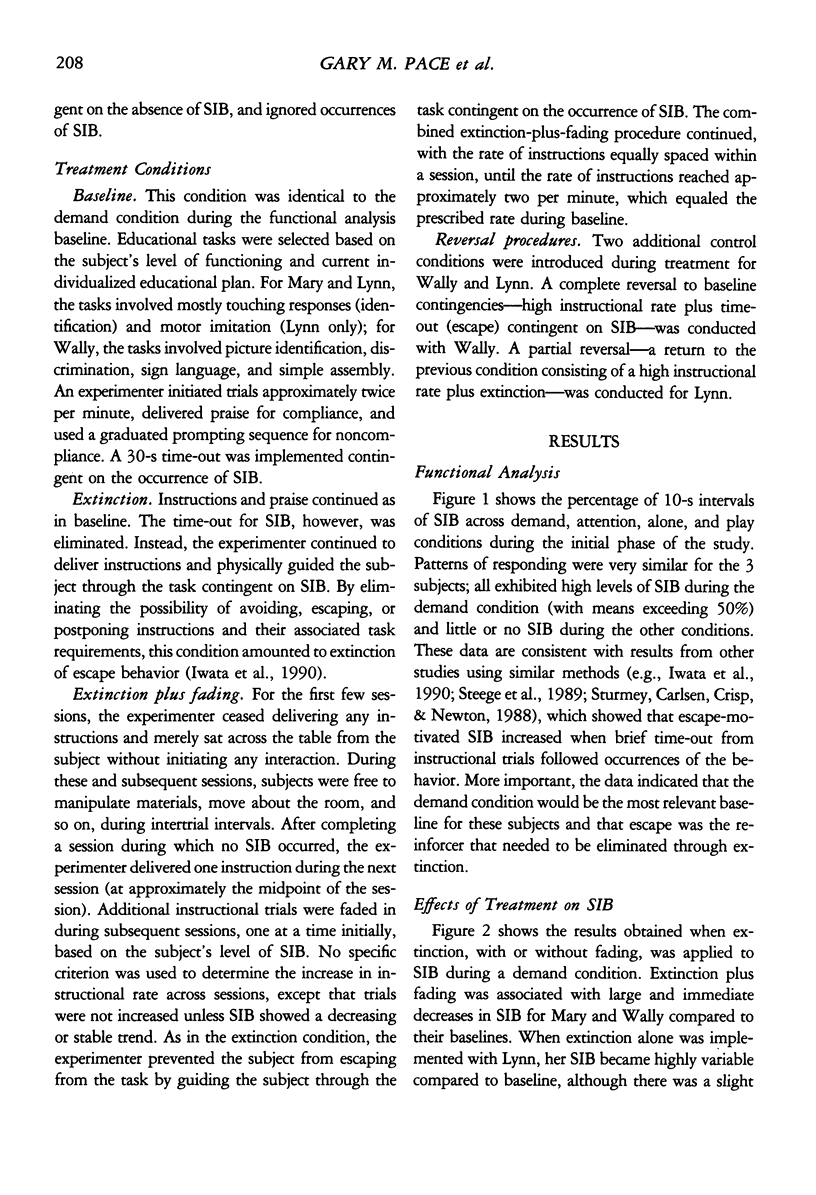Abstract
Three individuals with developmental disabilities were exposed to a series of assessment conditions to identify the source of reinforcement for their self-injurious behavior. In each case, self-injury occurred most often in instructional (demand) situations containing a brief time-out from the task contingent on self-injury, indicating that the behavior was an escape response (i.e., maintained by negative reinforcement). Treatment was implemented in a multiple baseline across subjects design and consisted of extinction (prevention of escape) plus instructional fading (initial elimination of instructions followed by their gradual reintroduction). Results showed that the combined treatment produced immediate and large reductions in self-injury that were maintained as the frequency of instructions was increased across sessions to match the original baseline rate of presentation. Results of a component analysis conducted with 1 subject suggested that stimulus fading accelerated the behavior-reducing effects of extinction.
Full text
PDF







Selected References
These references are in PubMed. This may not be the complete list of references from this article.
- Carr E. G., Durand V. M. Reducing behavior problems through functional communication training. J Appl Behav Anal. 1985 Summer;18(2):111–126. doi: 10.1901/jaba.1985.18-111. [DOI] [PMC free article] [PubMed] [Google Scholar]
- Carr E. G., Newsom C. D., Binkoff J. A. Stimulus control of self-destructive behavior in a psychotic child. J Abnorm Child Psychol. 1976;4(2):139–153. doi: 10.1007/BF00916518. [DOI] [PubMed] [Google Scholar]
- Day R. M., Rea J. A., Schussler N. G., Larsen S. E., Johnson W. L. A functionally based approach to the treatment of self-injurious behavior. Behav Modif. 1988 Oct;12(4):565–589. doi: 10.1177/01454455880124005. [DOI] [PubMed] [Google Scholar]
- Heidorn S. D., Jensen C. C. Generalization and maintenance of the reduction of self-injurious behavior maintained by two types of reinforcement. Behav Res Ther. 1984;22(5):581–586. doi: 10.1016/0005-7967(84)90062-7. [DOI] [PubMed] [Google Scholar]
- Horner R. H., Day H. M., Sprague J. R., O'Brien M., Heathfield L. T. Interspersed requests: a nonaversive procedure for reducing aggression and self-injury during instruction. J Appl Behav Anal. 1991 Summer;24(2):265–278. doi: 10.1901/jaba.1991.24-265. [DOI] [PMC free article] [PubMed] [Google Scholar]
- Iwata B. A. Negative reinforcement in applied behavior analysis: an emerging technology. J Appl Behav Anal. 1987 Winter;20(4):361–378. doi: 10.1901/jaba.1987.20-361. [DOI] [PMC free article] [PubMed] [Google Scholar]
- Iwata B. A., Pace G. M., Kalsher M. J., Cowdery G. E., Cataldo M. F. Experimental analysis and extinction of self-injurious escape behavior. J Appl Behav Anal. 1990 Spring;23(1):11–27. doi: 10.1901/jaba.1990.23-11. [DOI] [PMC free article] [PubMed] [Google Scholar]
- Mace F. C., Belfiore P. Behavioral momentum in the treatment of escape-motivated stereotypy. J Appl Behav Anal. 1990 Winter;23(4):507–514. doi: 10.1901/jaba.1990.23-507. [DOI] [PMC free article] [PubMed] [Google Scholar]
- Mason S. A., Iwata B. A. Artifactual effects of sensory-integrative therapy on self-injurious behavior. J Appl Behav Anal. 1990 Fall;23(3):361–370. doi: 10.1901/jaba.1990.23-361. [DOI] [PMC free article] [PubMed] [Google Scholar]
- Michael J. Distinguishing between discriminative and motivational functions of stimuli. J Exp Anal Behav. 1982 Jan;37(1):149–155. doi: 10.1901/jeab.1982.37-149. [DOI] [PMC free article] [PubMed] [Google Scholar]
- Repp A. C., Felce D., Barton L. E. Basing the treatment of stereotypic and self-injurious behaviors on hypotheses of their causes. J Appl Behav Anal. 1988 Fall;21(3):281–289. doi: 10.1901/jaba.1988.21-281. [DOI] [PMC free article] [PubMed] [Google Scholar]
- Steege M. W., Wacker D. P., Berg W. K., Cigrand K. K., Cooper L. J. The use of behavioral assessment to prescribe and evaluate treatments for severely handicapped children. J Appl Behav Anal. 1989 Spring;22(1):23–33. doi: 10.1901/jaba.1989.22-23. [DOI] [PMC free article] [PubMed] [Google Scholar]
- Steege M. W., Wacker D. P., Cigrand K. C., Berg W. K., Novak C. G., Reimers T. M., Sasso G. M., DeRaad A. Use of negative reinforcement in the treatment of self-injurious behavior. J Appl Behav Anal. 1990 Winter;23(4):459–467. doi: 10.1901/jaba.1990.23-459. [DOI] [PMC free article] [PubMed] [Google Scholar]
- Sturmey P., Carlsen A., Crisp A. G., Newton J. T. A functional analysis of multiple aberrant responses: a refinement and extension of Iwata et al.'s (1982) methodology. J Ment Defic Res. 1988 Feb;32(Pt 1):31–46. doi: 10.1111/j.1365-2788.1988.tb01386.x. [DOI] [PubMed] [Google Scholar]
- Wacker D. P., Steege M. W., Northup J., Sasso G., Berg W., Reimers T., Cooper L., Cigrand K., Donn L. A component analysis of functional communication training across three topographies of severe behavior problems. J Appl Behav Anal. 1990 Winter;23(4):417–429. doi: 10.1901/jaba.1990.23-417. [DOI] [PMC free article] [PubMed] [Google Scholar]
- Weeks M., Gaylord-Ross R. Task difficulty and aberrant behavior in severely handicapped students. J Appl Behav Anal. 1981 Winter;14(4):449–463. doi: 10.1901/jaba.1981.14-449. [DOI] [PMC free article] [PubMed] [Google Scholar]


